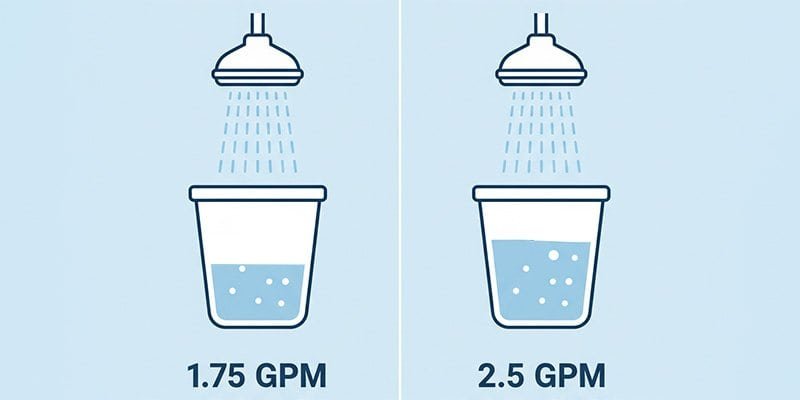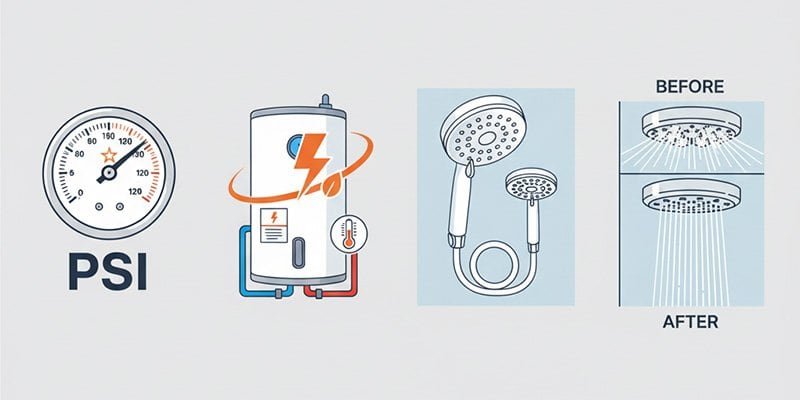Table of Content

When you choose a shower head, you’re picking more than just a bathroom fixture. You’re deciding how you want to balance a powerful shower with saving water and money. The key to this choice is GPM, or Gallons Per Minute, which tells you how much water your shower head uses every 60 seconds.
The big debate usually comes down to two options: the water-saving 1.75 GPM models and the standard 2.5 GPM versions. This guide will walk you through the pros and cons of each. We’ll look at the technology, the rules, and your personal needs so you can pick the shower head that’s right for your comfort, your budget, and your environmental goals.

What is Shower Head GPM?
GPM is just a simple way to measure water flow. A 1.75 GPM shower head uses 1.75 gallons of water every minute. A 2.5 GPM model uses 2.5 gallons in that same time. That 0.75-gallon difference per minute is where all the talk about water use, cost, and environmental impact begins.
You’ll find several common flow rates on the market, including 1.5 GPM, 1.75 GPM, 2.0 GPM, and the standard 2.5 GPM. Knowing where 1.75 GPM and 2.5 GPM fit in helps you understand their role in saving water and shaping your shower experience.
A Quick Look at the Rules
Shower head flow rates weren’t always regulated. Before the government stepped in, shower heads from the 1980s or earlier could use 3.5, 5.5, or even more gallons per minute. That’s a lot of water. This led to a major change focused on conservation.
A Quick Look at the Rules
The 2.5 GPM federal rule is a maximum, not a requirement everywhere. In 2010, the government allowed states to set their own, stricter standards. Many have, especially in areas where water is scarce. This means you need to check your local rules before you buy a new shower head. Here’s a quick look at the rules in several states.
| State/Region | Maximum Flow Rate (GPM) |
|---|---|
| Federal Standard | 2.5 GPM |
| California | 1.8 GPM |
| Washington | 1.8 GPM |
| Hawaii | 1.8 GPM |
| Oregon | 1.8 GPM |
| New York State | 2.0 GPM |
| New York City | 2.0 GPM |
| Colorado | 2.0 GPM |
| Vermont | 2.0 GPM |
| Massachusetts | 2.0 GPM |
| Maine | 2.0 GPM |
| Maryland | 2.0 GPM |
| New Jersey | 2.0 GPM |
| Washington D.C. | 2.0 GPM |
Always double-check your local city or county rules, as they can change.

The 1.75 GPM Shower Head: Good for the Planet and Your Wallet
If you want to save money and be environmentally friendly, the 1.75 GPM shower head is for you. It’s known as a “low-flow” or “water-saving” option for a good reason.
Why You’ll Like It
- Good for the Environment: This is the biggest plus. Using less water reduces your household’s water footprint. This helps conserve a vital resource and puts less strain on your local water systems.
- Saves You Money: Using less water means lower utility bills. A family of three, each taking a 15-minute shower, can save over 1,000 gallons of water a month by switching from a 2.5 GPM to a 1.75 GPM head. That adds up to real savings on your water and energy bills.
- Smart Technology: Don’t think “low-flow” means a weak shower. Old low-flow models were disappointing, but today’s versions are much smarter. They use technology like aerators, which mix air into the water to make the droplets feel bigger and fuller. Many people say they “don’t notice it is using less water”. Shower heads with the EPA’s WaterSense label (2.0 GPM or less) must perform as well as or better than regular ones.
What to Consider
- It Feels Different: If you’re used to a high-flow shower, a 1.75 GPM head might feel a bit weak at first. It can take some getting used to.
- Don’t Take Longer Showers: If you end up taking longer showers to make up for the lower flow, you’ll cancel out the water and money savings. The key is to keep your shower time the same.

The 2.5 GPM Shower Head: The Traditional, Powerful Choice
The 2.5 GPM shower head is the classic choice for a powerful, familiar shower experience. It’s the federal standard and what many people are used to.
Why You’ll Like It
- Powerful Flow: This is its main selling point. A 2.5 GPM head delivers a strong, invigorating shower that many people find more satisfying.
- Rinses a Lot Faster: The higher water volume is great for rinsing thick or long hair. You can get shampoo and conditioner out quickly, which saves you time and hassle.
- Shorter Showers: Because it rinses so well, you might find yourself taking shorter showers. This can help offset some of the extra water you’re using.
- Great Coverage: You get a wider, more drenching spray. This is nice in a big shower or if you need water to reach a shower bench.
- Flexible Options: Many 2.5 GPM heads have adjustable settings. You can switch to a lower flow rate on days when you want to save water, giving you the best of both worlds.
What to Consider
- Uses More Water: The biggest downside is that it uses more water—0.75 gallons more every minute compared to a 1.75 GPM model. For a family of three, that’s over 1,000 extra gallons a month.
- Higher Bills: More water use means higher water and energy bills over time.

More Than Just GPM: Other Things to Think About
Your shower’s GPM is important, but it’s not the only thing that matters. You also need to consider your home’s water pressure, your water heater, and the design of the shower head itself.
Water Pressure (PSI) vs. Water Flow (GPM)
People often mix these two up, but they are very different.
- GPM is Volume; PSI is Force: GPM (Gallons Per Minute) is how much water comes out. PSI (Pounds per Square Inch) is how hard the water is pushing through your pipes.
- More GPM Doesn’t Mean More Pressure: A higher GPM shower head lets more water through, which can feel like more pressure, but it doesn’t actually increase the water pressure in your pipes.
- Your Home’s PSI is Key: If you have strong water pressure (60-70 PSI), a 1.75 GPM shower head can feel great because there’s plenty of force behind the water.18 But if your home’s pressure is low (below 40 PSI), even a 2.5 GPM head might feel weak. If you have low pressure, you need to either fix the plumbing issue or buy a shower head designed for low-pressure homes.
The Hidden Cost: Your Water Heater
Saving water also means saving energy.
- Energy Savings: When you use a low-flow shower head, you use less hot water. This means your water heater doesn’t have to work as hard, which lowers your gas or electric bill. The EPA says an average family can save enough electricity to power a house for 11 days a year just by switching to a low-flow shower head.
- Hot Water Lasts Longer: Using less hot water per minute means your hot water tank won’t empty as quickly. This is great for families, as it means fewer cold showers.
Shower Head Design Matters
The same GPM can feel completely different depending on the shower head’s design.
- How it Feels: A 1.75 GPM rain shower head spreads water over a large area for a gentle feel. That same 1.75 GPM in a small, handheld head can feel like a powerful, massaging spray.
- Common Types:
- Fixed: The standard, wall-mounted head. Simple and reliable.
- Handheld: Attached to a hose, great for rinsing, cleaning the shower, or washing kids and pets.
- Rain: A large, overhead model that mimics rainfall. It’s more about relaxation than high pressure.
- Adjustable Settings: Many modern heads let you change the spray pattern and flow rate, so you can customize your shower.
Keeping It Clean
Your shower head won’t work well if it’s clogged.
- Clogs Kill Flow: Mineral deposits from hard water can clog the nozzles over time. This makes your shower feel weak, no matter the GPM.
- Easy to Clean: You can usually clear clogs by rubbing the nozzles with your finger. For tougher buildup, soak the head in a bag of white vinegar for a few hours. This will dissolve the minerals and get it working like new again.
How to Choose the Right GPM for You
So, how do you pick between 1.75 GPM and 2.5 GPM? It comes down to what you value most.
Ask Yourself These Questions:
- How important is saving water to me?
- What are the rules in my city or state?
- Is the water pressure in my house strong or weak?
- What kind of shower do I like? A strong blast or a gentle flow?
- Do I have special needs, like rinsing long hair or needing a wide spray?
- Do I want to save money on my utility bills?
Some General Advice
- If you want a powerful, quick shower and have no local rules against it: A 2.5 GPM shower head is a great pick. It’s excellent for “deep rinsing” and can help you get in and out of the shower faster.
- If you want to save money and help the environment: A 1.75 GPM (or lower) model is your best bet. Modern versions still give a great shower while cutting your bills and water use.
- If your home has low water pressure: Don’t just get a higher GPM head. Look for one specifically made for low-pressure homes. It will make the most of the force you have.
- If you’re still not sure, get an adjustable one: Many shower heads let you change the GPM and spray pattern. This gives you the freedom to choose what you want each day.
Shower Head Design Matters
The same GPM can feel completely different depending on the shower head’s design.
- How it Feels: A 1.75 GPM rain shower head spreads water over a large area for a gentle feel. That same 1.75 GPM in a small, handheld head can feel like a powerful, massaging spray.
- Common Types:
- Fixed: The standard, wall-mounted head. Simple and reliable.
- Handheld: Attached to a hose, great for rinsing, cleaning the shower, or washing kids and pets.
- Rain: A large, overhead model that mimics rainfall. It’s more about relaxation than high pressure.
- Adjustable Settings: Many modern heads let you change the spray pattern and flow rate, so you can customize your shower.
Keeping It Clean
Your shower head won’t work well if it’s clogged.
- Clogs Kill Flow: Mineral deposits from hard water can clog the nozzles over time. This makes your shower feel weak, no matter the GPM.
- Easy to Clean: You can usually clear clogs by rubbing the nozzles with your finger. For tougher buildup, soak the head in a bag of white vinegar for a few hours. This will dissolve the minerals and get it working like new again.
Few Final Tips
Once you’ve picked your shower head, here’s how to make the most of it.
Modifying Your Existing Shower Head
Most shower heads have a small plastic part inside called a flow restrictor. You can remove it to increase the water flow. But be careful. Doing this might violate your local water rules and could void the warranty on your shower head.
Other Ways to Save Water
Your shower head is just one part of the equation. You can always save more water with good habits. Try “taking shorter showers, turning off the water when lathering or shampooing, fixing leaks promptly, and installing aerators in faucets”.
Shower Head Design Matters
The same GPM can feel completely different depending on the shower head’s design.
- How it Feels: A 1.75 GPM rain shower head spreads water over a large area for a gentle feel. That same 1.75 GPM in a small, handheld head can feel like a powerful, massaging spray.
- Common Types:
- Fixed: The standard, wall-mounted head. Simple and reliable.
- Handheld: Attached to a hose, great for rinsing, cleaning the shower, or washing kids and pets.
- Rain: A large, overhead model that mimics rainfall. It’s more about relaxation than high pressure.
- Adjustable Settings: Many modern heads let you change the spray pattern and flow rate, so you can customize your shower.
Keeping It Clean
Your shower head won’t work well if it’s clogged.
- Clogs Kill Flow: Mineral deposits from hard water can clog the nozzles over time. This makes your shower feel weak, no matter the GPM.
- Easy to Clean: You can usually clear clogs by rubbing the nozzles with your finger. For tougher buildup, soak the head in a bag of white vinegar for a few hours. This will dissolve the minerals and get it working like new again.
Your Perfect Shower is Waiting
Choosing a shower head doesn’t have to be complicated. It’s all about what works for you, your home, and your values. With today’s technology, you don’t have to choose between a good shower and saving water.
Now you have the information you need to pick a shower head that gives you a great daily shower while helping you live more sustainably. Go find the perfect flow for you.
Frequently Asked Questions (FAQ)
Related Posts








